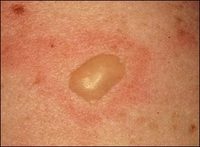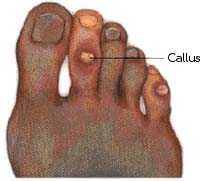


BLISTERS, CALLUS, CORNS
 |
 |
 |
Introduction
Did you ever get a blister from a new pair of shoes? Or maybe last fall you raked a lot of leaves and developed a callus on your hand? Or maybe you're a dancer and have noticed painful little bumps called corns on your toes?
Blisters, calluses, and corns can be uncomfortable, but they're also pretty common and easy to prevent. All three happen because of friction - which means that two surfaces rub against each other. In the case of these skin problems, one of the surfaces is your tender skin!
What's a Blister?
A blister is an area of raised skin with a watery liquid inside. Blisters form on hands and feet from rubbing and pressure, but they form a lot more quickly than calluses. You can get blisters on your feet the same day you wear uncomfortable or poor-fitting shoes. You can get blisters on your hands if you forget to wear protective gloves when you're using a hammer, a shovel, or even when you're riding your bike.
Areas on your body that form blisters and continue to be rubbed every day (like your feet because of the same pair of uncomfortable shoes you always wear to school) may go on to form calluses.
What's a Callus?
A callus is an area of thick skin. Calluses form at points where there is a lot of repeated pressure for a long period of time - such as the hours spent raking leaves. The skin hardens from the pressure over time and eventually thickens, forming a hard tough grayish or yellowish surface that may feel bumpy.
Calluses can be a form of protection for the hands. Gymnasts who perform on uneven parallel bars and other apparatus often get calluses on their hands, which take a lot of abuse. Guitar players also get calluses - on their fingers - from manipulating the strings. Once formed, calluses may make it easier for the person to swing around the bars or play the guitar.
Calluses on the feet, however, can be painful because you have to step on them all the time. They usually form on the ball of the foot. (The ball is the roundish part on the bottom of your foot, just behind your big toe.) Some calluses also form on the outside of the big or little toe or the heel. Tight shoes and high heels often cause calluses because they put a lot of pressure on your feet at points that aren't used to all of that stress.
What's a Corn?
Like calluses, corns are also areas of hard, thick skin. They're usually made up of a soft yellow ring of skin around a hard, gray center. They often form on the tops of the toes or in between toes. Like calluses, corns come from pressure or repeated rubbing of the toes. Corns usually develop after wearing shoes that are tight around the toe area.
How to Prevent Blisters, Calluses, and Corns
The best way to deal with blisters, calluses, and corns is to avoid getting them altogether. So how do you do that?
To avoid getting blisters and calluses on your hands, wear the right kind of gloves or protective gear. For instance, you might use work gloves during yard work or palm protectors called "grips" for gymnastics.
To keep your feet callus free, choose your shoes wisely. Try to shop for shoes in the afternoon - that's when your feet are their largest. Why? Because they get a little swollen from you walking on them all day! And be sure to try on both shoes and walk around a little bit before buying them. Even if they look really cool, don't get them if they don't feel right. Often, a different size or width can make a big difference.
And even if you love a certain pair of shoes in your closet, don't wear them all the time. Mix it up by wearing a variety of shoes. That way, your feet will get a break and won't always be rubbed in the same places.
Caring for Blisters, Calluses, and Corns
If any skin problem gets red, inflamed, or looks infected, your mom or dad will want to check with your doctor. But more often blisters, calluses, and corns can be cared for at home.
Disclaimer: This information is not intended be a substitute for professional medical advice. It is provided for educational purposes only. You assume full responsibility for how you choose to use this information.
Reviewed by: Patrice Hyde, MD
Date reviewed: September 2004